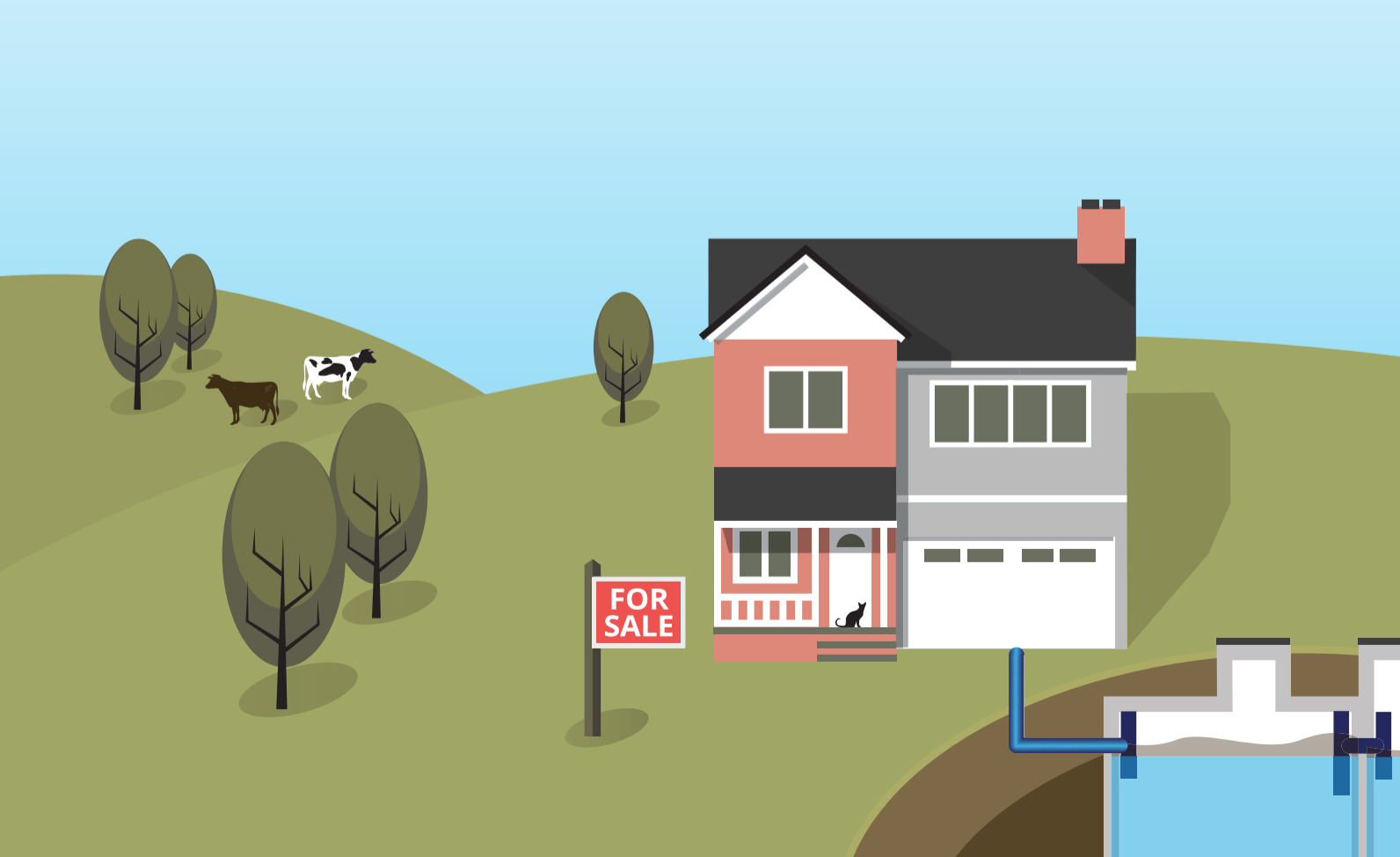Expert Guide
Buying a property with a septic tank
All you need to consider when buying a property with off mains drainage.

Avoid those nasty niffs
Picture the scene... You’ve just moved into your beautiful new rural home, the one you’ve had your heart set on for years.
You’re sat relaxing in the garden enjoying the fresh air, views of rolling hills and the sounds of the birds tweeting in the trees.
Don’t let the nasty niffs from a failing septic tank shatter that dream!
Here at UKDP we often get calls from people who have recently purchased their lovely new country pad. Then one day they start to notice trouble brewing underground. Perhaps strange smells coming from the garden, gurgling pipes, or murky boggy patches in the garden. So they call UKDP to find out what’s what.
The first thing to ask is whether a Home Buyer Drainage Survey was carried out. Unfortunately, the answer is nearly always ‘no’.
But there is no need to panic! Here is our indispensable guide to buying a property with a septic tank. It doesn’t have to be stressful, but you do need to know exactly what you’re taking on to avoid potential costly mistakes.

What does ‘off mains’ drainage mean?
Around 95% of properties in the UK have a mains drainage connection – waste water from toilets, showers, sinks and washing machines flow into a nearby main sewer. Charges are paid to a local water and sewage company.
The remaining 5% of properties, typically not situated near a main sewer, have their own self-contained off mains drainage system. This is usually a tank, which would either be a:
- Septic tank
- Sewage treatment plant
- Cesspit
Options 1 and 2 will then discharge to a soakaway system or pipework to a local watercourse.
Option 3 is just a holding tank for the waste, with no outlet.
What does owning a property with off mains drainage mean for you?
- You have a responsibility to make sure that your property’s drainage system does not cause pollution or harm to the environment.
- There are regulations in place that you must adhere to, and it’s important to be aware of them because you could be fined (or worse) if your system causes pollution.
- You won’t pay any charges to a water and sewerage company as you don’t connect to a main sewer.
- However, you will need to have your tank emptied regularly (roughly once a year for septic tanks and sewage treatment plants and 4-8 times a year for cesspits).
- If you have a sewage treatment plant, you will also need to have certain elements of it serviced regularly, approximately once a year.
What do you need to know when buying a property with off mains drainage?
Buying a property with off mains drainage needn’t be daunting, but you should enter any purchase negotiations with your eyes wide open, especially if it is the first time you have considered purchasing such a property.
Here are some things to consider and what you should be asking to ensure you avoid any unpleasant and costly post-purchase surprises.
- Has the tank been regularly emptied by the current owners?
- How much does the tank typically cost to empty? Can the current owners give you a guide as to what they pay locally?
- Is the tank shared with any other properties? If so, what agreements are in place around maintenance and repair of the system? What is the relationship like with the other property owners?
- Is any part of the drainage system outside of the property’s boundary? If so, what rights exist for access to maintain, repair or replace the system?
- If the property has a drainage field (a network of perforated or slotted pipes which allow waste water to percolate safely into the ground), is there enough room for a replacement one if it fails? These typically can’t be repaired, and also can’t be replaced in situ.
- What condition are the tank and the pipework in – are there any existing problems that need to be addressed? Remember, things may appear to be fine on the surface, but trouble underground can take time to manifest itself above ground.
How can you tell if there are problems?
The problem is, of course, that drainage systems sit out of sight underground, and it can be difficult to know what state it’s all in.
Things might seem as though they are working fine, but don’t take this at face value - problems underground can take time to show up above ground.
Even a standard building survey won’t go beyond a quick look into any manhole covers and a recommendation to get a specialist report. The condition of the drainage system is as fundamental to the wellbeing of the property as that of the roof, so don’t make the move without knowing exactly what you’re taking on.
The answer? The Home Buyer Drainage Survey.
Why is a Home Buyer Drainage Survey important?
First and foremost, peace of mind. When you’ve got your heart set on a property, the last thing you want to do is find out about any possible problems.
Often the survey will reveal a well-maintained system that should continue to provide many years of trouble-free use. Or it may reveal some issues that need addressing – and of course it’s much better to know about these before the sale has gone through. Either way, your Home Buyer Drainage Survey will give you the complete reassurance that comes with knowing the exact condition of the property you are purchasing – from top to bottom.
All for a fixed fee that is a fraction of the cost of a replacement drainage system.
Buying a property is the biggest investment you will likely make, and with
a Home Buyer Drainage Survey, you can be confident in the decisions you are making.
What does a Home Buyer Drainage Survey cover?
- A diagram showing the layout of the drainage system.
- Confirmation (or otherwise) that the tank is adequately sized for the property and for modern living.
- Confirmation (or otherwise) that the drainage set up is following current legislation and that it will abide by the new legislation starting in 2020.
- Reporting of any damage found within the tank which may cause problems e.g. splits, fractures or any root ingress.
- Confirmation (or otherwise) that all elements of the system infrastructure are in place and in good working order.
- CCTV footage of any accessible pipework and confirmation of its condition.
- Where issues are identified, we will provide recommendations (repair or replacement) and guideline costs.
- All the above will be contained within a detailed formal report and the CCTV footage provided to you for future reference.

Got some questions?
We are a friendly team of specialists with decades of combined experience. We're here to help.

Got some questions?
We are a friendly team of specialists with decades of combined experience. We're here to help.




